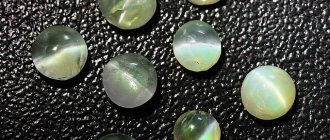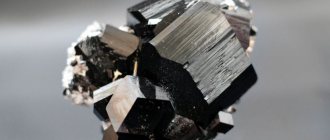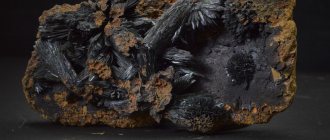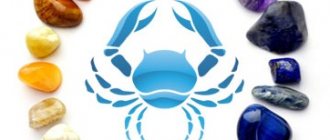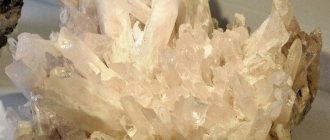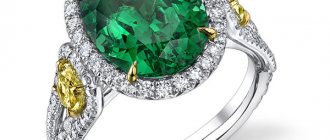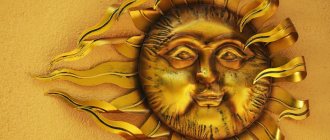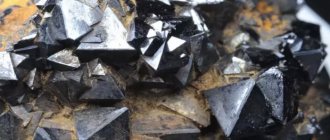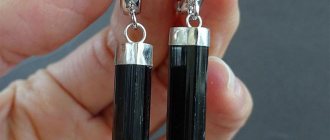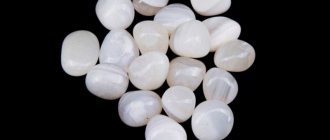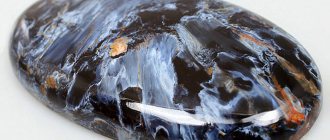History and origin
Before heliolite burst into the list of semi-precious minerals and received recognition and its own name, the stone went through a path of research, trial and error. The first official name sounded like “sodium spodumene”. The Swedish scientist Berzelius gave this unusual name to the mineral in 1824. Two years later, the German mineralogist Friedrich Breithaupt renamed the gem “oligoclase.” And only in 1841 one of the oldest nuggets received the modern name “heliolite,” which literally means “sun stone” in Greek.
Mineral – Heliolite
The name “sunstone” often refers to golden minerals with a characteristic shimmer, such as amber, aventurine, carnelian, citrine, andesine or selenite. But this is only a poetic comparison, introducing unnecessary discord into the names of minerals.
An ancient legend tells about the appearance of golden feldspar on earth. At the time of the birth of the world, nothing existed except water. In the morning the Sun rose, and his only occupation was contemplating his own reflection in the endless ocean. Seeing the Moon appear at night, the Sun, tired of narcissism, wanted to get to know her. So for a whole week the Sun made attempts to catch up with the Moon, not understanding why it was running away. On the eighth day, the Sun realized that he was not destined to meet the Moon. The luminary began to cry, and the tears rolling from his hot eyes turned into sun stones.
Another legend speaks of a miraculous connection between heliolite and the Sun, as if confirming the first legend. There was a belief that the sun stone helped the Vikings who traveled the seas to see the Sun through clouds, fog and even below the horizon. In those days, compasses did not yet exist, but brave sailors always returned home from long voyages. The beautiful fairy tale about the magic stone has found a scientific basis in our days.
A polished heliolite crystal that served as a compass was found in the wreckage of a Scandinavian ship. Through experiments, it was proven that the gem actually shows the exact location of a star that is out of sight - behind the clouds and even beyond the horizon. The solution to the wonderful effect is simple - through the stone the sky is visible in a gray-blue color, and only the point where the sun is located glows yellow.
Also read: Feldspar - the building material of the Earth
The origin of the mineral is metamorphic and igneous. In nature, it occurs in the form of prismatic or tabular crystals, occasionally forming granular or solid masses.
Where is it used?
Heliolite is a jewelry variety of microcline from the group of feldspars. The areas of application are determined by the properties and appearance of the material.
Jewelry making, decor
Heliolite is classified as a semi-precious stone.
Thanks to perfect cleavage, the sample can be easily split into smooth plates. Decorators use this property to create flat inserts and overlays for decorative items.
Heliolite decoration
Cabochons (beads) are used in the jewelry segment.
Collecting
The object of the hunt for collectors of mineral collections is heliolite crystals. In nature, they are found less often than granular masses, therefore they are valued higher.
Another desirable acquisition is green and grayish samples.
We recommend: KUNZITE – calm in pink tones
Other areas
Heliolite is slightly vulnerable to acids; acid-resistant ceramics are made from it.
Scientists studying rock metamorphism value ore as a marker in determining the age, conditions and depth of these processes.
Physical properties
| Property | Description |
| Formula | K[AlSi3O8] |
| Hardness | 6 — 6,5 |
| Density | 2.74 g/cm³ |
| singonia | Triclinic |
| Kink | Conchoidal |
| Shine | Glass, mother-of-pearl |
| Cleavage | Perfect |
| Transparency | Opaque or translucent |
| Color | Various shades of yellow, orange and red, but there are also gray and green specimens with shiny inclusions. |
The chemical composition of the stone is very complex, rich, and unstable. The characteristic golden tint and glow are provided by inclusions of goethite and hematite, which interfere with sunlight.
The mineral is quite hard, but at the same time it has perfect cleavage, which makes it incredibly fragile - with a slight blow, heliolite splits into thin plates of various shapes (rhombuses, triangles, hexagons, rectangles). The nugget does not dissolve in acids.
Physico-chemical characteristics of the gem
Heliolite is a sodium-calcium aluminosilicate consisting of albite and anorthite. Its chemical formula is (Na,Ca)Al(Si,Al)3O8. Sometimes it contains Ba, Sr, FeO, Fe2O3, etc. as impurities. As can be seen from the chemical formula, the mineral does not have a constant composition. The gem consists of 70-50% albite and 50-30% anorthite. Therefore, physical properties have different meanings.
Hardness (on the Mohs scale) – 6.5-7 units, density – 2.62-2.76 g/cm3. A fairly hard mineral, however, it is very brittle due to its perfect cleavage. A simple blow breaks the stone into plates with a smooth surface. The mineral can be found in the form of a crystal, but more often in the form of grains.
Medium hardness is very convenient for jewelry processing of the mineral: polishing or cutting.
The gem is very widespread in the world. It is mined in South and North America, Europe, and Africa.
The first large deposits of stone were discovered in the depths of the Andes. Forty years later, the same deposit was discovered in the USA. The gem was given a personal name - Oregon Sunstone. It has a unique golden-red luster caused by numerous small inclusions of native copper. Over time, heliolite has become a symbol of the state of Oregon.
Types of stone
Heliolite is classified according to the color palette of the stone. Moreover, each variety is characteristic of a specific deposit. Therefore, the mineral was conditionally divided according to the place of extraction:
- Mexican is a dark straw-colored mineral.
- Indian - a gem in terracotta tones.
- Oregon is the most beautiful gem. Features a high degree of transparency. The main color is straw yellow, shining brightly with golden-reddish highlights. It also comes in peach and pink. The most unusual specimens are greenish-blue nuggets.
- Congo stone is a red mineral. There are also light green specimens.
- Tanzanian - sparkling gray-green gem.
- Norwegian is a mineral of the brown and orange palette.
Do you know that Oregon heliolite soon after the discovery of the deposit in the American Oregon (1980) became a symbol of this state.
Many specimens have asterism and a “cat’s eye” effect.
Also read: Sapphire is a stone signifying power and immortality
Hyalite deposit
The mineral of different colors is mined in different parts of the planet.
For example, the most valuable stone, bluish with a pearlescent sheen, is mined in Australia. Orange (sometimes with a green tint) is called honey.
The darkest hyalites - yellow-brown - are also valued, as they tend to shimmer with all the colors of the rainbow.
But they are not as rare as blue ones, and are mined both in Europe and Asia.
Medicinal properties
The centuries-old history of heliolite has given healers of all times the opportunity to study the versatile capabilities of the stone. The beneficial properties of the mineral are aimed at treating:
- nervous disorders (depression, stress, chronic fatigue);
- heart diseases;
- allergies;
- respiratory diseases (any type of colds);
- problems of the gastrointestinal tract, kidneys.
Various treatment methods:
- massages;
- applying;
- contemplation;
- wearing jewelry;
- drinking charged water.
Since the solar gem manifests its qualities to the maximum in combination with jade, water is charged in jade vessels. To do this, the heliolite crystal is left in such a container for a day, after which charged water is taken as a medicine.
Magic properties
Ancient peoples - the Greeks, Canadian Indians - used heliolite for spiritualistic séances, at which they communicated with the souls of people who had left this world. The natives of the United States used the solar gem to protect their territories from evil spirits.
Modern esotericists consider heliolite to be especially useful for males. This mineral gives the owner optimism, enhances attractiveness in women’s eyes, develops intuition, and preserves youth.
Solar Nugget has a reputation as an energetically positive stone. The talisman protects a person from misfortune, imparts positivity, and helps to find a way out of the most dead-end situations.
Important! Heliolite is a stone of clear action, capable of guiding decisive people. Therefore, weak-willed individuals are not recommended to acquire such a talisman. The mineral will suppress the remnants of will in such a person, thereby attracting swindlers, swindlers, and dishonest people.
In order for the stone to maximize its magical abilities, it is subjected to complex types of cutting. Heliolite serves as an attribute of white magicians - the solar nugget does not obey black sorcerers.
Jewelry with mineral
The solar mineral is used to make all types of jewelry. The setting is made of both jewelry alloys and precious metals, which affects the cost of the products:
- Earrings made of brass, decorated with faceted heliolite beads with a diameter of 13 mm and sodalite beads with a diameter of 4 mm – 1800 rubles.
- Silver twisted ring with a solo stone – 3000 rubles.
- A bracelet measuring 17 cm made of sunstone beads (10mm), complemented by a jade bead (18mm) on an elastic silicone thread - 2900 rubles.
- Pendant made of 585 gold with a total weight of 10.5 grams (4.4 grams of gold) - 16,200 rubles.
Also read: Black diamond is a mineral of happiness and love
Ring
Men's accessories (cufflinks, tie clips) are often made to order.
Price
Heliolite is classified as semi-precious or ornamental, prices are moderate (RUB):
- bracelet – 3,900 – 5,600;
- pendant – 570 – 760;
- ring – 3,700 – 11,500;
- earrings – 3,200 – 9,800.
This is the cost of the silver assortment.
Tumbling (1.5-2 cm) from India can be bought for 420 - 640 rubles. a piece.
How to spot a fake
An imitation of heliolite is plastic or glass. It is not difficult to distinguish a sunstone from a fake:
- Heliolite is massive, heavy, cold. The natural mineral heats up slowly in the palms. Any fake quickly absorbs heat and is noticeably lighter in weight.
- The natural nugget is endowed with iridescence.
The main feature of heliolite will help determine the naturalness of the mineral - it indicates the location of the sun. The gem will emit a characteristic glow in any weather.
How to wear and care
Jewelry with heliolite is considered universal, regardless of gender or age. The stone is equally good to wear during the day or in the evening. Traditionally, jewelry is associated with everyday style, walking, meeting with friends. Products made from precious metals are appropriate for the office, parties, and dates.
The peculiarity of care is to be careful - the gem should not be dropped or subjected to impacts, otherwise it will crack. Store separately, avoid prolonged exposure to direct sunlight, which causes the mineral to become faded. For cleaning use a warm soap solution. After drying, the nugget is polished with a velvet cloth.
Beads with Heliolite
Astrological compatibility
The energy of the stone appeals to representatives of the element of Fire - Leo, Aries, Sagittarius. The talisman will provide comprehensive support to these signs, ensure continuous replenishment of lost energy, and support internal fervor. Thanks to the amulet, Fire signs will become more balanced, which will help avoid conflicting work or family situations.
Pisces, Scorpios, Cancers - signs of Water - are not the best company for the solar mineral. Constant struggle will bring more harm than good to people born under these constellations.
Air and earth Zodiacs can safely choose heliolite talismans. The gem will not play a vital role, but it will not cause harm either.
Is this stone right for you?
Who is suitable according to their zodiac sign?
According to the horoscope, the sun stone is most suitable for the signs of the element of Fire:
- Aries , under his influence, will become more compliant and will take into account the opinions of other people. Relationships with loved ones, colleagues, and friends will improve.
- Leo will receive good luck from heliolite, the ability to sensibly assess difficult situations and find the right way out of them. A heliolite amulet will protect you from dangers.
- Sagittarius will feel the help of the sunstone to a lesser extent than Aries and Leo. You can keep it at home, but if you wear it, then not all the time.
From time to time you can wear it for signs of the Earth element:
- Taurus will find in him a friend who will help in difficult moments to find the right path, the right decision. The mineral promotes success in work and career.
- Virgo and Capricorn will be fueled by the warm energy of the sunstone, their relationships with others will improve, and people will be pleased to communicate with them.
towards the signs of the Air element - Gemini, Aquarius, Libra . It suits them only as decoration.
Astrologers do not recommend wearing this stone for “Water” signs. People born under the constellations of Pisces, Cancer, Scorpio can become too trusting and vulnerable. Lucky stones for them: ammolite (ammonite), aventurine, sodalite, belomorite, labradorite, moonstone.
In addition, in terms of energy they are ideal for Cancer and Pisces : cacholong, morganite (sparrowite), pearls, euclase, aragonite, orthoclase.
For Cancer and Scorpio : selenite, hematite, chrysoberyl.
For Pisces and Scorpio : coral, jet, opal.
Also perfect compatibility:
- in Pisces : with morion, fluorite, anhydrite (angelite), prasiolite, blue agate, spinel, rose quartz, jasper, amethyst.
- for Cancer : with chalcedony, black diamond, agate, emerald, cat's eye, tektite, petersite.
- for Scorpio : marcasite, bull's eye, pyrite, amazonite, alexandrite, howlite, kunzite, unakite, rhodochrosite, sarder, garnet, rich red carnelian (carnelian), aquamarine, topaz.
